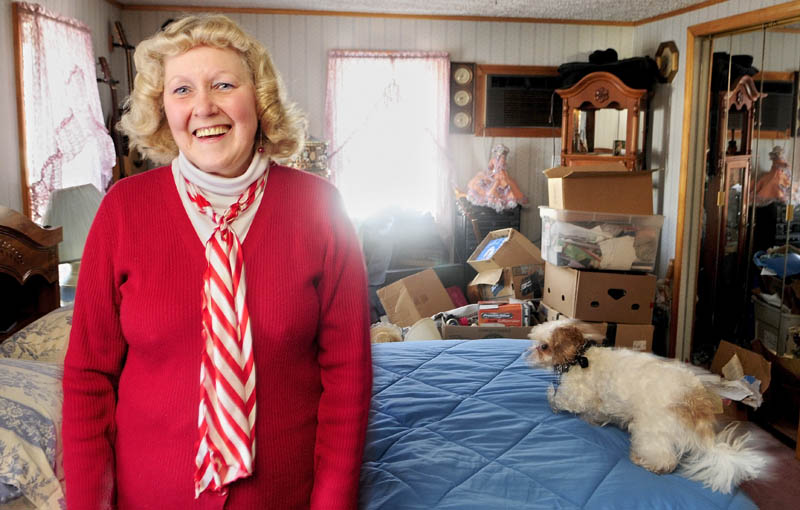AUGUSTA — In the mid 1980s, the city acquired the Fort Western Tire Co. property on Cony Street to house the new City Center.
The city gave the company owners, the Loiko brothers, $400,000 and plenty of notice and the Loikos relocated their business to North Belfast Avenue.
Then, in March 2003, the state condemned the Loikos’ new site to make way for construction of a new bridge in north Augusta to connect Route 3 to Interstate 95.
The risk of another move was too much to take for company present John Loiko Sr., so the family closed the business. Eventually the company received $681,000 from the state.
Several other people lost their homes to the construction of the road and Cushnoc Crossing bridge.
Today, the state is engaged in a similar process of taking land to make Interstate 95’s exit 113 a full interchange and extend Route 3 across I-95 to Route 27, known locally as Civic Center Drive. Road project costs are estimated to total nearly $11 million, with all levels of government and MaineGeneral Medical Center picking up the tab.
“Against popular belief, we don’t like to take property,” said Todd Pelletier, property office director for the state Department of Transportation’s Bureau of Project Development. “If we take somebody’s property, it’s usually our last resort. Obviously, it’s costly. It lengthens the process, and first and foremost it’s the one right people have that tends to be theirs.”
Pelletier acknowledged that the houses and properties carry memories — trees they’ve planted, children they’ve raised.
“It one of the most emotional things we deal with,” Pelletier said. Relocation specialists working for the state, he said, have to be “feeling, understanding, and compassionate.”
Most residential landowners in the Cushnoc Crossing project were satisfied with the resettlement process, but some landowners, particularly those with commercial enterprises still are not — including Loiko.
In the new project, the state will take two houses for the exit 113 build-out, which includes construction of two roundabouts just a bit smaller than Cony Circle.
One belongs to Kenneth R. Bonsant. His home of 48 years on Old Belgrade Road is close to Medical Center Way, the driveway to the new $310 million regional hospital under construction by MaineGeneral Medical Center.
Bonsant recently found a new house near the Burns Road area — about four miles away from his previous home — which he’ll move into soon.
The other home and adjacent property belong to Shirley Kinney. That site is farther west, near the intersection of Old Belgrade Road and Route 27. It is needed to square off the intersection with Wilson Street, where a traffic signal will be installed.
Kinney, who has lived there for 51 years, said she is trying to find a new house. “I’ve been looking and looking, and I can’t find anything,” she said.
The state valued her property at $90,000. Instead of receiving a direct payment, Kinney said the department will help her get a similar home and pay moving expenses.
Kinney wants to remain in the same area of the city so her 9-year-old granddaughter can stay at the same school. She wants a spot for a garden, too.
“I’d like to be in the country,” she said, recalling that the area surrounding her home years ago was all blueberry fields.
In fact, when Kinney and her late husband, Leland, moved there, they had to install a bathroom. Previously, the property had only an outhouse.
Today, her guitars — she’s a country singer — still hang on the wall, but rooms hold half-packed boxes in anticipation of the move. She watches vehicles pass by along both Route 27 and Old Belgrade Road.
“The traffic on both sides is bad,” she said.
How property is taken
The construction project also will involve the state acquiring temporary construction rights and some “strip takes” of property where the road is to be widened, but all those sites are still being identified, according to Scott Avore, chief property officer.
“We have to determine there’s a public need before we use eminent domain for transportation purposes and safety,” Avore said.
Much property taking involves providing proper notice to the landowner — a minimum of 90 days if the landowner has to relocate — but the state tries to tell people much earlier than that, Avore said.
The state sends in appraisers, mostly certified general appraisers, to calculate compensation for the property. Pelletier said the appraisal is different from a bank appraisal and it involves reviewing comparable real estate sales.
Once notified that their property will be taken, most people say, “I want to get out of there as soon as you can get me out of there,” Pelletier said.
Along with the compensation amount, there’s a relocation benefit to assist with the move, which averages about $25,000.
The money pays for all closing costs associated with acquiring a new home, a home inspection, radon tests and all moving costs by a commercial moving company up to 50 miles.
“The uniform act is set up to try to protect (the homeowners) and put them in at least as good a situation afterwards,” Avore said. “There’s a lot of gray areas where you can be creative.”
The aim is to relocate people into housing that is “decent, safe and sanitary,” which officials refer to as DSS.
Pelletier said the process is stressful for homeowners. But, “When we buy a residence, they’re almost always satisfied with the outcome.”
Betty Adams — 621-5631
badams@centralmaine.com
Send questions/comments to the editors.



